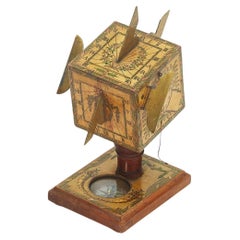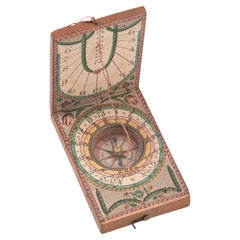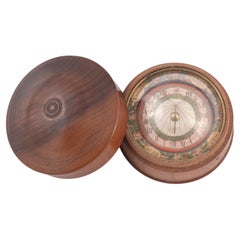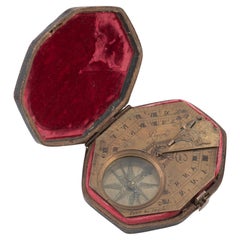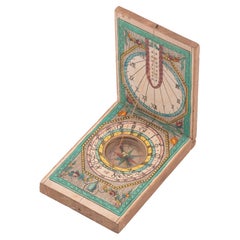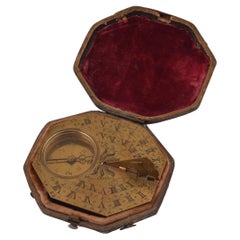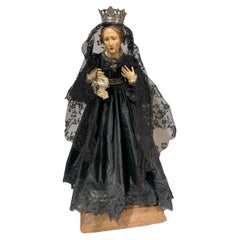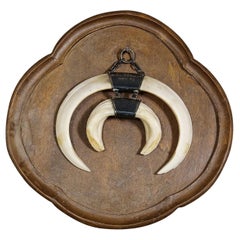Neoclassical Scientific Instruments
Neoclassical design emerged in Europe in the 1750s, as the Age of Enlightenment reached full flower. Neoclassical furniture took its cues from the styles of ancient Rome and Athens: symmetrical, ordered, dignified forms with such details as tapered and fluted chair and table legs, backrest finials and scrolled arms.
Over a period of some 20 years, first in France and later in Britain, neoclassical design — also known as Louis XVI, or Louis Seize — would supersede the lithe and curvaceous Rococo or Louis XV style.
The first half of the 18th century had seen a rebirth of interest in classical antiquity. The "Grand Tour" of Europe, codified as a part of the proper education of a patrician gentleman, included an extended visit to Rome. Some ventured further, to sketch the ruins of ancient Greece. These drawings and others — particularly those derived from the surprising and rich archaeological discoveries in the 1730s and ’40s at the sites of the Roman cities of Pompeii and Herculaneum — caused great excitement among intellectuals and aesthetes alike.
Neoclassical furniture is meant to reflect both grace and power. The overall appearance of neoclassical chairs, tables and cabinetry is strong and rectilinear. These pieces are, in effect, classical architecture in miniature: chair and table legs are shaped like columns; cabinets are constructed with elements that mirror friezes and pediments.
Yet neoclassicism is enlivened by gilt and silver leaf, marquetry, and carved and applied ornamental motifs based on Greek and Roman sculpture: acanthus leaves, garlands, laurel wreaths, sheaves of arrow, medallions and chair splats are carved in the shapes of lyres and urns. Ormolu — or elaborate bronze gilding — was essential to French design in the 18th and 19th centuries as a cornerstone of the neoclassical and Empire styles.
As you can see from the furniture on these pages, there is a bit of whimsy in such stately pieces — a touch of lightness that will always keep neoclassicism fresh.
Find antique neoclassical furniture today on 1stDibs.
Late 18th Century German Antique Neoclassical Scientific Instruments
Wood
Late 18th Century German Antique Neoclassical Scientific Instruments
Paper
Early 19th Century German Antique Neoclassical Scientific Instruments
Wood
1790s French Antique Neoclassical Scientific Instruments
Brass
1810s German Antique Neoclassical Scientific Instruments
Paper
Early 18th Century French Antique Neoclassical Scientific Instruments
Metal, Bronze, Other
Late 18th Century German Antique Neoclassical Scientific Instruments
Bronze, Other
18th Century French Antique Neoclassical Scientific Instruments
Bronze, Other
18th Century European Antique Neoclassical Scientific Instruments
Bronze
19th Century European Antique Neoclassical Scientific Instruments
Copper, Iron
1840s Spanish Antique Neoclassical Scientific Instruments
Bronze
19th Century French Antique Neoclassical Scientific Instruments
Bronze, Enamel, Ormolu
Late 18th Century Italian Antique Neoclassical Scientific Instruments
Terracotta, Fabric, Wood
Late 20th Century German Neoclassical Scientific Instruments
Metal
Mid-20th Century German Neoclassical Scientific Instruments
Antler, Wood
Early 19th Century Austrian Antique Neoclassical Scientific Instruments
Silver, Brass
Mid-19th Century Italian Antique Neoclassical Scientific Instruments
Wood
Early 1900s German Antique Neoclassical Scientific Instruments
Porcelain, Fabric, Wood
1850s Unknown Antique Neoclassical Scientific Instruments
Natural Fiber
1850s German Antique Neoclassical Scientific Instruments
Pine
19th Century German Antique Neoclassical Scientific Instruments
Bone
1910s Vintage Neoclassical Scientific Instruments
Brass
Late 18th Century German Antique Neoclassical Scientific Instruments
Brass
19th Century Italian Antique Neoclassical Scientific Instruments
Fabric, Wood, Paint
1790s Spanish Antique Neoclassical Scientific Instruments
Bronze
19th Century French Antique Neoclassical Scientific Instruments
Metal
1820s Spanish Antique Neoclassical Scientific Instruments
Bronze
Early 1700s Spanish Antique Neoclassical Scientific Instruments
Bronze
Late 19th Century European Antique Neoclassical Scientific Instruments
Metal, Other
Late 19th Century European Antique Neoclassical Scientific Instruments
Metal, Enamel
Late 18th Century French Antique Neoclassical Scientific Instruments
Wood, Paper
Early 20th Century French Neoclassical Scientific Instruments
Ormolu, Bronze
19th Century French Antique Neoclassical Scientific Instruments
Metal
Late 18th Century Italian Antique Neoclassical Scientific Instruments
Slate
Late 19th Century French Antique Neoclassical Scientific Instruments
Enamel, Ormolu
